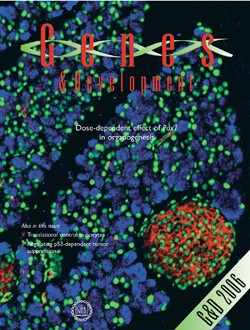
Christopher Wright, D.Phil.
Gene’s role in pancreas development scrutinized

Wright and colleagues' research was featured on the cover.
Cover courtesy of Cold Spring Harbor Laboratory Press
A team of Vanderbilt University Medical Center investigators has taken another step forward in understanding the genetic “triggers” that coordinate pancreas development and normal pancreatic cell function.
Christopher V. E. Wright, D.Phil., and colleagues report in the Jan. 15 issue of Genes & Development that the timing and level of expression of a gene called Pdx1 — not just its presence or absence — is critical for pancreas development and function.
The studies have implications for developing cell-based therapies for diabetes, for example from embryonic stem cells, and for suggesting new targets for genes that increase the risk of diabetes in humans.
“When I think about making embryonic stem cells turn into pancreatic tissue, I want to know how few transcription factor triggers I have to turn on to elicit the entire program,” said Wright, professor of Cell & Developmental Biology and director of the Program in Developmental Biology.
“It's important to know that you have to turn these triggers on to certain levels, and that's where this study is going to be important.”
Wright and others have demonstrated in the past that Pdx1 is critical for pancreas development. Mice that have been engineered to completely lack the gene do not develop a pancreas, and there are severe abnormalities in other organs of the foregut — the stomach, pylorus and duodenum.
In the current studies, Wright and colleagues focused on the “control” region of the Pdx gene. They deleted a segment of that region and studied how that deletion affected pancreas and foregut development and function in the adult animal.
The altered Pdx1 gene turned “on” later and at lower levels compared to the normal gene. Mice with two copies of this altered gene failed to develop a pancreas, but they did develop a relatively normal-looking stomach, pyloric region and duodenum, Wright said.
“It was surprising how little protein you need to be able to develop those tissues,” he said.
Mice with only one altered copy of the Pdx1 gene along with a normal copy had abnormal pancreatic islet cells and developed diabetes as early as four weeks of age, suggesting that a low “dose” of Pdx1 may predispose humans to diabetes.
“Pdx1 is important in mature beta cells for making insulin and for regulating a lot of other genes that keep a beta cell working,” Wright said. “There might be people with mutations in the control region of the Pdx gene that alter its levels and leave their islets unable to work properly.”
There is evidence supporting this idea, Wright added. Mutations in other genes that are known to work through Pdx1 have been linked to certain genetic forms of diabetes, called MODY types of diabetes (maturity-onset diabetes of the young).
“Our studies suggest that we need to be looking for mutations or alterations in the control regions of these critical genes like Pdx1 in humans,” Wright said.
“We're providing additional support for the idea that Pdx is a nexus through which multiple inputs are coordinated and come indirectly to the insulin gene.”
The research was supported by the NIH and by fellowships to the lead author, Yoshio Fujitani, M.D., Ph.D.













